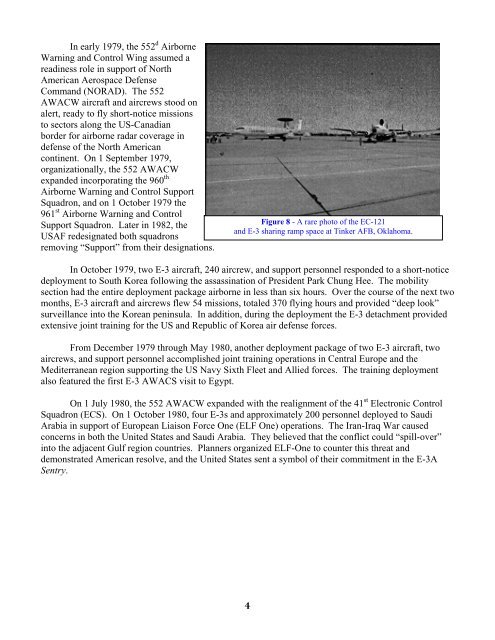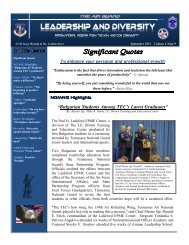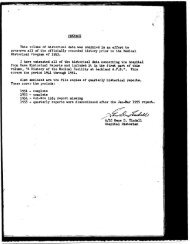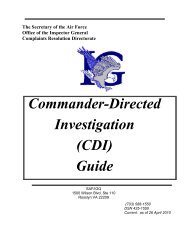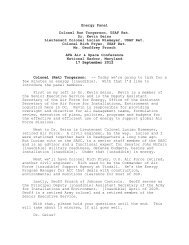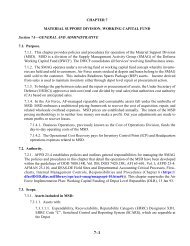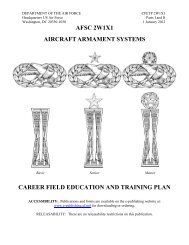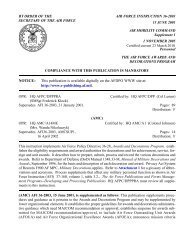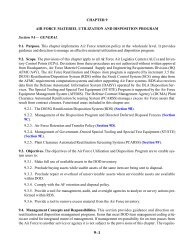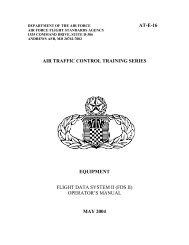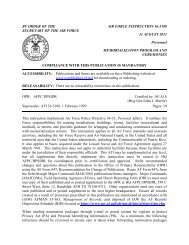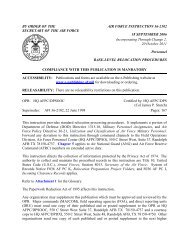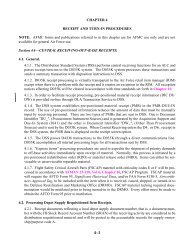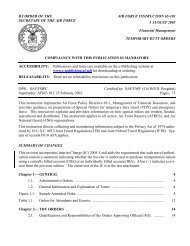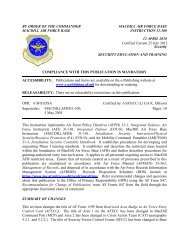Operational History of the 552 - Air Force Link
Operational History of the 552 - Air Force Link
Operational History of the 552 - Air Force Link
Create successful ePaper yourself
Turn your PDF publications into a flip-book with our unique Google optimized e-Paper software.
In early 1979, <strong>the</strong> <strong>552</strong> d <strong>Air</strong>borne<br />
Warning and Control Wing assumed a<br />
readiness role in support <strong>of</strong> North<br />
American Aerospace Defense<br />
Command (NORAD). The <strong>552</strong><br />
AWACW aircraft and aircrews stood on<br />
alert, ready to fly short-notice missions<br />
to sectors along <strong>the</strong> US-Canadian<br />
border for airborne radar coverage in<br />
defense <strong>of</strong> <strong>the</strong> North American<br />
continent. On 1 September 1979,<br />
organizationally, <strong>the</strong> <strong>552</strong> AWACW<br />
expanded incorporating <strong>the</strong> 960 th<br />
<strong>Air</strong>borne Warning and Control Support<br />
Squadron, and on 1 October 1979 <strong>the</strong><br />
961 st <strong>Air</strong>borne Warning and Control<br />
Support Squadron. Later in 1982, <strong>the</strong><br />
USAF redesignated both squadrons<br />
removing “Support” from <strong>the</strong>ir designations.<br />
Figure 8 - A rare photo <strong>of</strong> <strong>the</strong> EC-121<br />
and E-3 sharing ramp space at Tinker AFB, Oklahoma.<br />
In October 1979, two E-3 aircraft, 240 aircrew, and support personnel responded to a short-notice<br />
deployment to South Korea following <strong>the</strong> assassination <strong>of</strong> President Park Chung Hee. The mobility<br />
section had <strong>the</strong> entire deployment package airborne in less than six hours. Over <strong>the</strong> course <strong>of</strong> <strong>the</strong> next two<br />
months, E-3 aircraft and aircrews flew 54 missions, totaled 370 flying hours and provided “deep look”<br />
surveillance into <strong>the</strong> Korean peninsula. In addition, during <strong>the</strong> deployment <strong>the</strong> E-3 detachment provided<br />
extensive joint training for <strong>the</strong> US and Republic <strong>of</strong> Korea air defense forces.<br />
From December 1979 through May 1980, ano<strong>the</strong>r deployment package <strong>of</strong> two E-3 aircraft, two<br />
aircrews, and support personnel accomplished joint training operations in Central Europe and <strong>the</strong><br />
Mediterranean region supporting <strong>the</strong> US Navy Sixth Fleet and Allied forces. The training deployment<br />
also featured <strong>the</strong> first E-3 AWACS visit to Egypt.<br />
On 1 July 1980, <strong>the</strong> <strong>552</strong> AWACW expanded with <strong>the</strong> realignment <strong>of</strong> <strong>the</strong> 41 st Electronic Control<br />
Squadron (ECS). On 1 October 1980, four E-3s and approximately 200 personnel deployed to Saudi<br />
Arabia in support <strong>of</strong> European Liaison <strong>Force</strong> One (ELF One) operations. The Iran-Iraq War caused<br />
concerns in both <strong>the</strong> United States and Saudi Arabia. They believed that <strong>the</strong> conflict could “spill-over”<br />
into <strong>the</strong> adjacent Gulf region countries. Planners organized ELF-One to counter this threat and<br />
demonstrated American resolve, and <strong>the</strong> United States sent a symbol <strong>of</strong> <strong>the</strong>ir commitment in <strong>the</strong> E-3A<br />
Sentry.<br />
4


